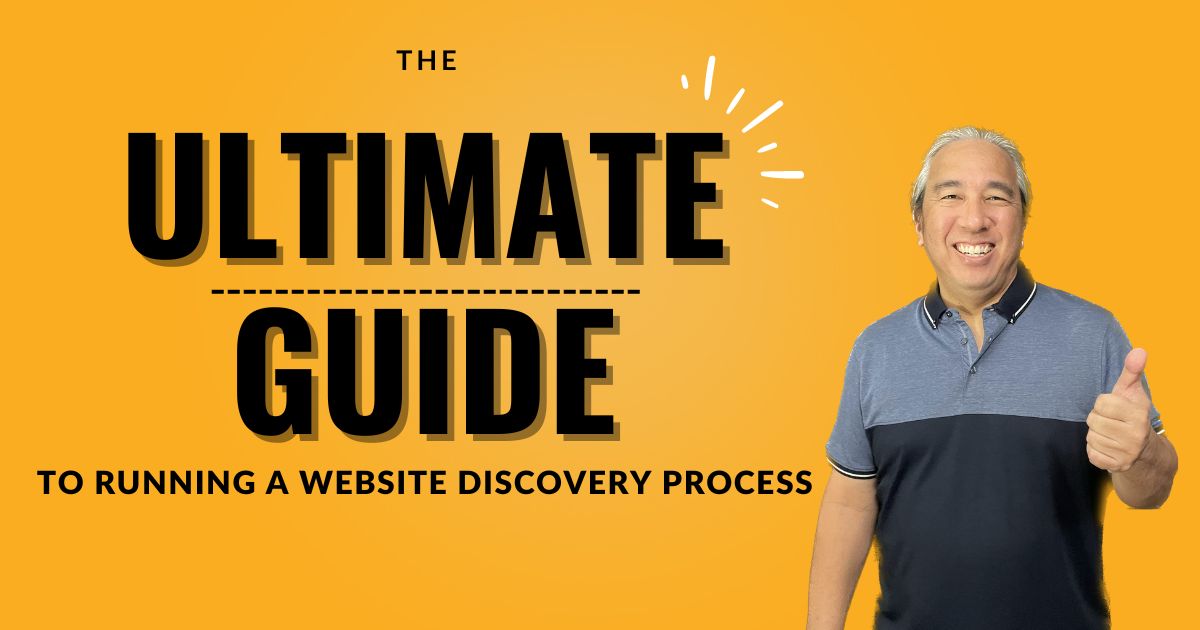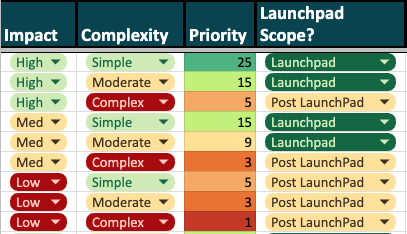14 min
The Ultimate Guide to Running a Website Discovery Process
By David Lee

As a former agency owner, I have run so many different variations of the website discovery process from simple questionnaires all the way up to in depth website strategy analysis.
And to no one’s surprise, the more I dug into my client's business, the easier it was for my team to create awesome content and designs. By asking questions about their goals, customers, and competition, I got a clearer picture. This helped my writers figure out what message to say, and my designers knew what visuals would look best.
Benefits from running an in depth Discovery process
-
New requirements were uncovered
-
Existing requirements were refined
-
The customer psychology was better understood
-
The pages needed to craft the messaging was defined
-
The organization of the site was solidified
Because the Discovery Process was included in the overall contract which was already signed up frton, it cause some difficulties and left me with two choices:
-
Take a hit on the profit margin for the project
-
Renegotiate the scope of work with our client with a change order.
In order to avoid change orders, I usually padded the web design bid by 20-30% and hoped that it would be enough to cover the changes in scope.
However, this approach can backfire for both the agency and the client.
Unclear project requirements at the outset leads to inflated estimates which may be an overkill and can leave clients over paying.
Or as the agency, I still have a risk of scope creep that is above and beyond the padding.
A Better Way to run the Discovery Process
To avoid client relationship issues or excessive padding of bids, I adopted this approach:
-
Carve out the Discovery Process as a separate bid from the rest of the web design project
-
As requirements and pages are documented, the client needs to sign off on exactly which pages and requirements are in scope for the initial website launch and what features can be scheduled in as an after launch activity.
-
Once the requirements and scope is understood and approved by the client, then create two bids: one for content and the other for the web design, build, test and deploy.
By following this process, both the client and agency can have a documented understanding of the scope and the estimated cost of the website can be made with a high degree of confidence.
Who Should Read This Guide?
-
Companies who are looking to redesign their website and have been burned in the past with loose requirements and poor expectation setting.
-
Web Design Agencies who are looking to properly scope out a new website project and want an independent 3rd party to collect and prioritize the business and technical requirements so that their content and technical teams can generate accurate bids and reduce the chances of scope creep and project time delays.
When I run the Discovery Process, I divide the workflow into three separate components:
-
Website Strategy
-
Content Strategy
-
Business Requirements
Website Strategy
Let’s start out with what most people define as website strategy: A roadmap or a plan on how to achieve your website goals.
But that not quite correct. Creating a strategy is not the sale as creating a plan.
Let’s instead take a look at how Harvard defines strategy:
“Strategy is making trade-offs in competing.
The essence of strategy is choosing what not to do.”
So in order to figure out your website strategy you get the key stakeholders for the business in a room to discus and make the following choices:
Choice 1: What Kind of website do you need?
There are basically two types of websites:
-
Company Focused Website: Educate prospects on the products and services your company offers.
-
Customer Focused: Educate prospects on the products and services your company offers AND demonstrate that you understand your customers’ problems and educate visitors on possible solutions to their problems.
Usually smaller companies or pure e-commerce companies fall into Company Focused Websites.
But, if you are a B2B company and what you sell is a considered purchase, then you really need to have a customer focused website.
Choice 2: Who do you want to target?
You can’t target everyone and be effective.
You need to have a specific target audience in order to create an effective website. I typically recommend creating 2-3 user personas.
A good buyer persona doesn't just have demographics like age, education, gender, title and role at a company. That doesn’t go into enough detail about why they are making a purchase..
Instead you need more in depth user research to understand their psychology and decision making process. These are the three main questions to ask:
-
What problems are they trying to solve?
-
What happens to them personally if they fail?
-
How is your company positioned to help them avoid failure?
Remember, people buy on emotion and justify with logic. Or as Professor Gerald Zaltman at Harvard Business school writes:
“95% of our purchase decisions take place unconsciously...
...our conscious mind will always make up
reasons to justify our unconscious decisions.”
Choice 3: What needs to be fixed with the new website?
Forget (for now) the specific marketing and sales KPIs to track that us marketers like to throw around.
Instead, think of the three business functions of a website:
-
Attract new visitors
-
Engage and Educate the visitors
-
Turn visitors into leads
Examine the performance of your website and force rank which of these business functions needs to be fixed first, then second and thrid.
It's important to prioritize which web site issue you need to fix first. If all three are your #1 priority, then none of them are a priority. Again, strategy is about making choices.
The good news is that this priority ranking can and should change after the website launch. A key concept to having a high performing website is to make continuous improvements after the launch.
The output from the business strategy are:
-
Agreement on what type of website is needed
-
Two to three in depth buyer personas
-
Prioritized list of goals for the website
Content Strategy
The content strategy choices are a bit more nuanced. It really comes down to making decisions on what content needs to be in place at launch and what content will be created after launch.
There are certain pages that need to be included in the launch of the website.
Required Pages
-
Home
-
Products
-
Services
-
Industries
-
Solutions
-
Capabilities
-
Careers
-
About Us
-
Team
-
Locations
-
Contact Us
The real choices come into play with the educational articles.
These educational articles form the foundation for other marketing tactics like Paid advertising, Social Media, email Marketing, and Account Based Marketing.
So part of the decision is to determine how soon after the website launch will you start traffic generating campaigns.
Types of educational content:
-
Problem / Solution
-
Technical Reports
-
Case Studies
-
White Papers
-
Testimonials
-
Advice
-
Tips and FAQ
-
How to articles
In addition to the types of content, you also need to consider the mediums:
Content Mediums
-
Text based content including blogs and ebooks
-
Visuals such as infographics, charts, and presentations
-
Audio such as podcasts and webinars
-
Video including explainer, vlogs, tutorials and lectures
In order to control project scope, it is essential to identify not only which pages will be on the website, but what other educational content and the format needs to be on the initial launch.
These are all decisions that need to be identified, discussed and approved by the business stakeholders so that it is clear to the content creators and design/development team on what is in scope and what needs to be done.
The output from the content strategy are:
-
Page List - a list of every page that the website needs to have
-
Site Map - a document that shows the organization of these pages.
Business Requirements
Documenting solid business requirements is probably the most difficult task in the Discovery process.
Inexperienced business consultants often confuse the goals and issues with their current website with the business requirements.
While it's good to know the goals and issues, they are not specific enough for content creators and designers to correctly scope out the project.
For example
| Bad Requirement | Good Requirement |
|
Site need to be multilingual [This is too high level of requirements] |
Site needs to support English and Spanish on all pages including product descriptions and legal pages. Spanish content needs to be translated by a native speaker and not Google Translate. |
|
Establish ACME’s as the leader in the life sciences industry [This is a goal, not a requirement] |
Create 10 pieces of educational content to demonstrate how ACME is a leader in the life science industry. 5 problem/solution pages 3 white papers 2 case studies Site should also have a dedicated life sciences industry page that is targeted to the engineer buyer persona. |
|
Increase brand awareness
[This is a goal and not a requirement] |
Create 20 pieces of content to increase brand awareness.
At launch, 5 written articles about problems that exist in the life sciences industry and what possible solutions are available. (This needs to be done without selling ACME’s solutions)
After launch, create 5 written achilles per month for 3 months to reach the goal of 20. |
|
Outdated formatting
[This is an issue] |
A new style guide needs to be created so that the website, digital media and printed media all have the same look and feel.
The style guide should include logo, colors, fonts, image styles, and usage guidelines. |
Writing good requirements is to document the WHAT in sufficient detail that the creative and technical teams can work from without going back to the business users for clarification.
PRO TIP: I usually start off with asking: What does the website need to do?
Business Requirements Process
In order to scope and plan a website project, it's not enough to have a simple punch list of functionality requirements.
You also need to:
-
Document, in detail, the business requirements of the the new website.
-
Have the technical team evaluate each requirement and determine how difficult / complex each business requirement is and add in technical requirements.
- Get sign off and agreement with the business and technical teams on which requirements are MUST have vs NICE to have at the website launch,
When documenting requirements, I break this website discovery phase into three sections.
1) Meet with the Business Users
This usually takes 2 meetings with the project team business users, subject matter experts and stakeholders for the web project.
Meeting #1 - Collecting Requirements
The first meeting takes between 1 to 2 hours. Here we brainstorm and document what the website needs to do.
Most of the time the business users have a good idea of what they need the website to do, but it's often at too high of a level.
As a result, I often need to ask a lot of questions to make sure that the requirements are documented to the correct level that the content writers and developers need in order to do their jobs.
Meeting #2 - Ranking Requirements
The second meeting is typically shorter, lasting around an hour. During this session, I work with the business users to prioritize the requirements.
For each requirement we assign a Business Impact rating of high, medium, or low to distinguish between essential features ("must-haves") and desirable features ("nice-to-haves").
A key challenge here is ensuring everyone understands the prioritization process. Assigning equal importance to everything dilutes the concept of priority.
2) Meet with the Technical Team
To assess requirement complexity, I collaborate with either your in-house development team or preferred external agency.
If you haven't identified a development partner yet, I bring in my trusted web development partners for this exercise.
It’s critical that the technical team go through each of the requirements and assign a Technical Complexity score of Simple, Moderate or Complex. In addition, any technical requirements are documented.
This is usually a one to two hour meeting.
Based on the Business Impact and Technical Complexity a new rating of Priority is created.
3) Joint Business and Technical Team meeting
This is perhaps the most important meeting because it defines what is in and out of scope for the launch of the website.
During this joint meeting, both teams review and discuss the Business Impact, Technical Complexity and Priority Rating of each requirement to determine which ones are in and out of scope for the initial launch of the website. It looks like this:

The output from this process are a detailed list of requirements that are
-
Detailed Requirements are signed off by the business.
-
Level of complexity of implementing requirements have bee assessed by the technical team.
-
All Requirements and pages are Prioritized and Ranked.
Summary
By following this process you get all of the documents necessary to properly scope and plan the website design process with a minimal amount of “padding” from the web agency / team.
The three main deliverables from this discovery phase are:
1) The Website Strategy documents
-
The purpose of the website redesign project.
-
Identification of the target audience with 2-3 in depth buyer personas.
-
Ranked business objectives of the website.
2) The Content Strategy documents
-
The list of all of the pages and other digital assets that need to be on the new website.
-
The organization of the pages on the website (site map).
3) The Requirements Workshop documents
-
What the new website needs to do at launch
-
What features can be implemented after launch
By securing sign-off on the project scope and requirements from both the business team and the technical team, we can create a far more accurate cost estimate and timeline.
The agency minimizes risk, and the company sets realistic expectations for management regarding the website's capabilities.
How will you run your website discovery process?
